|
June 1953 QST
 Table of Contents Table of Contents
Wax nostalgic about and learn from the history of early electronics. See articles
from
QST, published December 1915 - present (visit ARRL
for info). All copyrights hereby acknowledged.
|
My career involving controlled movement
of electrons began with working around high voltages and currents. In electrical
vocational classes, the instructor lectured on the potential (pun intended) harm
that could be done to life and property because of ignorance or inattention to the
job at hand. Safety practices were reviewed prior to allowing us plebes to handle
not just 3-Ø, 480 V supplies for motors, but also for household AC circuits
and low voltage sources with high current outputs. We all had the opportunity to
get 'lit up' with 115 Vac and even 230 Vac if we dared
(a practice that would never be allowed in today's environment).
We watched films (no VCRs back then) showing poor
souls who had been the victims of electrocution. It was all enough to convince me
that the experts weren't kidding. Nevertheless, even with a healthy respect for
being hurt, there were times when I would accidently come in contact with a live
wire and feel that unmistakable 60 Hz tingle and internally induced buzzing
sound. I still have my linemans' pliers from nearly 40 years ago that have scars
from melting caused by inadvertently providing a path to ground while grasping a
hot wire with the jaws. One time I burned a large screwdriver in half while working
inside a circuit breaker panel. One of the major rules, covered in this article,
is to when possible keep one hand in your pocket when working with live circuits.
That minimizes the chance of a current passing through your heart, which is one
of the most certain scenarios for death by electrocution.
How to Live Longer
Safety Technique for Ham Equipment
By Donald H. Mix * W1TS
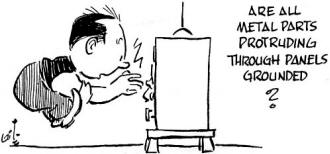 Over a period of years a goodly number of
hams have met death at the hands of their equipment. The really surprising thing
is that there have not been more of them, considering the high voltages often used
in transmitters. Especially in these days when thousands of new hams are coming
into the game with limited background in things electrical, it is important to make
everyone of them realize the very real danger of death or serious injury that may
lie in wait behind an innocent-looking panel. Over a period of years a goodly number of
hams have met death at the hands of their equipment. The really surprising thing
is that there have not been more of them, considering the high voltages often used
in transmitters. Especially in these days when thousands of new hams are coming
into the game with limited background in things electrical, it is important to make
everyone of them realize the very real danger of death or serious injury that may
lie in wait behind an innocent-looking panel.
This article deals with the things that every operator should observe in building
and operating his equipment with a minimum of danger not only to himself but to
the rest of his household. Read it carefully and make a firm resolution that you
won't be the next one!
Several years ago, shocked by the sudden death by accidental electrocution of
one of its foremost members, the Headquarters staff held a series of conferences.
The object was to study current ham practices, particularly in regard to transmitter
construction and adjustment, and to formulate a set of rules that should minimize
chances of accidental injury or death. This set of recommendations was published
in the March, 1939, issue of QST. Although we continue to lose good, but not always
careful, hams at the rate of about three a year through high-voltage accidents,
we hope that the publication of the ARRL Safety Code has served to save the lives
of many others. For this reason, we feel that it is worth while to remind all hams,
once again, that any piece of electrical gear is capable of dealing out sudden death.
TVI, still" just around the corner" when the Safety Code was first published,
has not been without its beneficial influence on the design and construction of
ham gear. Not only has it forced us into the production of cleaner signals, but
the requirement of shielding enclosures has made ham rigs vastly safer to operate
and work around. Today, the greatest hazard probably is the one that lurks around
the test bench with its upended chassis and temporary power leads. This should be
borne in mind when reading the recommendations that follow.
There are two ways by which the danger may be minimized. The first is that the
operator train himself to follow a procedure of operation and adjustment that will
minimize his chances of coming in contact accidentally with any exposed high-voltage
point. The second consists of methods of construction that will provide a minimum
of exposed high-voltage points with which contact can be made. The second should
actually be considered supplementary to the first to reduce the hazard, should the
operator forget. It is seldom possible to construct a piece of equipment that can
be handled indiscriminately with any degree of safety while the power is turned
on. Of course, no ham knowingly will touch a danger point with the power turned
on. But by following certain rules, the chances of a thoughtless act having a tragic
result can be minimized.
Rules for the Operator
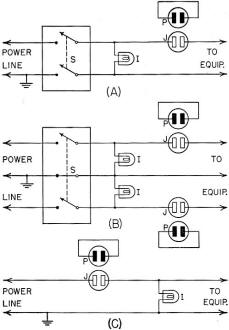
Fig. 1 - Reliable arrangements for cutting off all power
to the transmitter. S is an enclosed double-pole knife-type switch, J a standard
a.c. outlet, P a shorted plug to fit the outlet and I a red lamp.
A is for a two-wire 115-volt line, B for a three-wire 230-volt
system, and C a simplified arrangement for low-power stations. All are discussed
in detail in the text.
A) Kill all power circuits completely before touching anything behind the panel
or inside the chassis or enclosure.
The easiest way to make sure that this rule is followed is to make the operation
of turning off all power a simple one. A single main switch should be provided that
cuts off all power from the equipment. The use of one plainly-labeled switch for
this purpose, instead of several individual switches. for various circuits, obviously
not only makes it easy for you to become automatic in eliminating all danger, but
it also makes it readily possible for someone else not familiar with control-circuit
details to cut the power off quickly should you forget and get "hung up" across
the high voltage.
Toggle switches and other similar spring-operated switches, or relays of the
sort most frequently used by hams for power control, are not sufficiently reliable
for this important purpose. While automatic interlock circuits are fine as secondary
devices to help protect you in case of forgetfulness, don't let your life depend
on them. They have been known to fail, particularly when they control relays that
may stick closed at any time.
There are at least two devices for cutting off all power to the transmitter that
are about as foolproof as anything could be. The arrangement is shown m F1g. 1.
A and B are similar circuits for two-wire (115-volt) and three-wire (230-volt) systems.
S is an enclosed double-throw knife switch of the sort usually used as the entrance
switch in house installations. J is a standard a.c. outlet and P a shorted plug
to fit the outlet. The switch should be located prominently in plain sight and members
of the household should be instructed in its location and use. I is a red lamp located
alongside the switch. Its purpose is not so much to serve as a warning that the
power is on as it is to help in identifying and quickly locating the switch should
it become necessary for someone else to rescue you.
The outlet J should be placed in some corner out of sight where it will not be
a temptation for children or others to play with. The shorting plug can be removed
to open the power circuit if there are others around who might inadvertently throw
the switch while you're working on the rig. If you take the plug with you, it will
prevent someone from turning on the power in your absence and either injuring themselves
or the equipment or perhaps starting a fire.
Those who are operating low power and fecl that the expense or complication of
the switch isn't warranted can use the shorted-plug idea as the main power switch.
In this case, the outlet should be located prominently and identified by a signal
light, as shown in Fig. 1C.
The test bench ought to be fed through the main power switch, or a similar arrangement
at the bench, if the latter is remote from the rig.
B) Never permit anyone else to switch the power on and off for you while you
are working on equipment.
 Always do the power switching yourself.
Having someone else do it is too risky, even though you are giving the orders. There's
too much chance of a misunderstanding and, after all, you don't want to make someone
else bear the responsibility for your execution. Always do the power switching yourself.
Having someone else do it is too risky, even though you are giving the orders. There's
too much chance of a misunderstanding and, after all, you don't want to make someone
else bear the responsibility for your execution.
C) Never put your hands into any gear without first using a grounded probe at
all exposed points.
Bleeder resistors, even though conservatively rated, are not infallible, and
a fully-charged filter condenser can be just about as lethal as the supply with
the power turned on. The probe will also serve as a secondary line of defense in
case you should forget to turn the power off. Short-circuit the power supply with
the probe instead of your arms. Always jab a bare terminal with the probe before
changing plug-in coils. This is a good habit to form, even though you may be using
parallel feed in your present rig. It may save your life some day when you're working
on another piece of gear of your own or belonging to someone else. Touch the probe
to all exposed points just in case a burn-out makes one point cold while others
are still hot.
The sketch of a suitable homemade probe is shown in Fig. 2. The handle of
the probe ought to be long enough so that you don't have to put your hand close
to the equipment to use it. A total length of about 18 inches should be safe. The
insulating handle and wire are to save you in case the ground lead opens up. It
is obvious, of course, that you must be sure that there is a solid circuit between
the grounding point of the probe wire and the negative terminal of the plate supply
(and positive terminal of the bias supply).
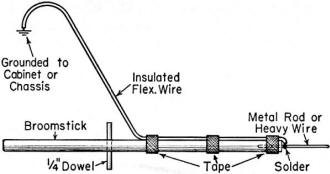
Fig. 2 - A homemade insulated grounding probe. Such a device
should always be used to ground exposed high-voltage points before touching anything
behind the panel. It serves to protect the operator against charged filter condensers
or if he forgets to turn the power off.
If you are working on gear on the test bench, make sure that power supplies and
probe are connected to the same ground and that you use the probe at each power-input
terminal before touching anything underneath the chassis.
D) When shooting trouble, make sure that you are well clear of the gear before
turning on the power.
Don't place yourself in an awkward or unbalanced position while you push the
key with one hand and try to stretch around a corner to see what's happening behind
the panel. If you should slip or lose your balance, you might fall into the high
voltage. Use a push button, or other momentary-contact switch on the end of a cord
for power control, so that you can keep yourself well in the clear. The push-button-type
switch opens automatically and this might at least keep you from frying if an accident
happens.
E) Stay clear of grounded metal while you're working on the rig.
Don't lean against the cabinet, chassis, or other grounded metalwork. And, above
all, don't wear headphones while you're working on equipment or changing coils.
While the voltages in a receiver, exciter or speech amplifier may not be above 2.50,
your chances will still be pretty slim if your head is at one end of the circuit.
A good rule to follow is to keep one hand in your pocket. There will be less danger
of a shock passing through a vital part of your body. If the rig or test bench is
in the basement, you ought to provide a rubber mat around it.
F) Never adjust variable links by hand. Adjustable links can be highly dangerous
with a series-feed tank circuit. Not only does manual adjustment bring your hand
too close to the tank coil, but the clearance between the link and the tank coil
is never very great, making contact between the tank coil and link all too easy.
If the coil design doesn't provide a means of fitting the link with a panel control,
use a long stick for adjustment. Shielded links or links grounded at one side or
a center tap will prevent high voltage from appearing unexpectedly on the link cable.
G) Don't work on equipment (or try to change plug-in coils) when you're tired
or otherwise not up to snuff mentally.
Mental or physical fatigue is invariably accompanied by a certain amount of absentmindedness.
Wait until you are fully alert.
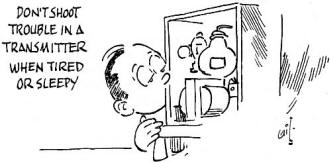 H) Use special care when checking tank circuits
with an absorption wavemeter. H) Use special care when checking tank circuits
with an absorption wavemeter.
The use of absorption wavemeters in checking tank-circuit resonances and harmonics
has become everyday practice, and yet what could be more dangerous than a bare coil
stuck in a hot tank circuit while the operator watches the indicator rather than
where he is putting the coil? Use a well-insulated link line between the tank and
wavemeter coils and ground the case of the wavemeter (which should always be of
metal) with a clip lead.
I) Never pull test arcs from the transmitter tank circuit.
This warning really shouldn't be necessary, of course. It is singled out from
other foolhardy conduct around a transmitter only because a great many of us have
a natural temptation to do it. The r.f. may not cause anything more than a nasty
burn, but an r.f. arc isn't an insulator and can easily conduct d.c. through a pencil
or screwdriver. Play safe and resist the temptation.
J) Teach members of your household how to apply artificial respiration.
Many lives have been saved after electrical shock by the prompt and proper application
of artificial respiration by a bystander. The usual methods used by physicians in
detecting life in victims of accident often do not apply in the case of electric
shock. Cases are on record where victims, apparently dead, have been brought around
after as much as four hours of seemingly hopeless pumping. Regardless of other indications,
hope should not be given up until there is definite indication of rigor mortis.
Prompt action is highly important. Don't wait for a pulmotor to arrive. Instruction
sheets can be obtained from your local Red Cross office and often at fire or police
stations. If possible, always have someone else in the room while you're working
on equipment.
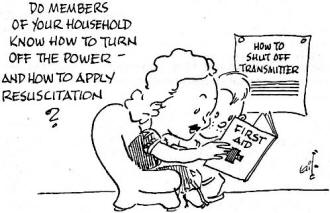 However, a most-important point is that
everyone should be warned of the danger of con-tact with a person who has been injured
and who may still be in contact with the high voltage. Make sure that members of
your household understand that the power must be turned off first. There have been
several instances where women and children have been killed or injured in attempting
to remove an unconscious person still in contact. However, a most-important point is that
everyone should be warned of the danger of con-tact with a person who has been injured
and who may still be in contact with the high voltage. Make sure that members of
your household understand that the power must be turned off first. There have been
several instances where women and children have been killed or injured in attempting
to remove an unconscious person still in contact.
Equipment Design and Construction
So much for the rules of operator conduct in the presence of electrical equipment.
If they are followed religiously, there is small chance of an accident. However,
forgetfulness is a part of human nature and the unfortunate part of it is that electricity
has no sympathy for a first-time offender. The first moment of forgetfulness may
be your last! Therefore, it is the sensible ham who will construct his equipment
so that it won't be easy to get hurt even if he forgets.
1) Panel Controls and Metering
It shouldn't be necessary to point out that every control shaft extending through
the front of the panel should be at ground potential. To make certain of this, ground
every control shaft to the panel either directly or by the use of panel-bearing
units wherever an insulating shaft coupling is used. The frames of key or metering
jacks must be fastened to the grounded panel. Never mount them with insulating washers.
This, of course, essentially dictates metering and keying in the cathode or center
tap.
If you want metering in the positive leads, use meter switching instead of jacks.
Meters, unless connected in the cathode or centertap lead, should be recessed so
that there will be no danger of contact with the adjusting screw.
2) Power Supply
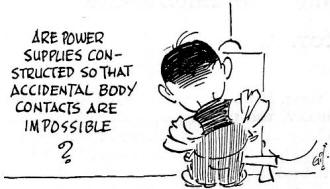 Enclose all power supplies, or construct
them so that contact with any part of the circuit is impossible. You don't want
to stick your knee into the power supply while you're concentrating on keeping clear
of the r.f. units. Power supplies seldom need adjustment, and there is no reason
why they can't be enclosed. However, most modern power-supply components are designed
so that they may be mounted with their terminals protruding under the chassis where
there is normally little chance of accidental contact. Rectifier plate caps should
be of the insulated type. Similarly there should be no exposed terminals. Use insulated
plug-type connectors designed for the proper voltages at the test bench as well
as at the rig. In using these connectors, make sure that all live connectors are
of the female type. For example, always use a female connector on the power-supply
chassis, and another at the transmitter end of the cable. Use a male connector on
the transmitter chassis. Enclose all power supplies, or construct
them so that contact with any part of the circuit is impossible. You don't want
to stick your knee into the power supply while you're concentrating on keeping clear
of the r.f. units. Power supplies seldom need adjustment, and there is no reason
why they can't be enclosed. However, most modern power-supply components are designed
so that they may be mounted with their terminals protruding under the chassis where
there is normally little chance of accidental contact. Rectifier plate caps should
be of the insulated type. Similarly there should be no exposed terminals. Use insulated
plug-type connectors designed for the proper voltages at the test bench as well
as at the rig. In using these connectors, make sure that all live connectors are
of the female type. For example, always use a female connector on the power-supply
chassis, and another at the transmitter end of the cable. Use a male connector on
the transmitter chassis.
All negative plate-supply and positive bias-supply terminals should be connected
to the chassis and the chassis connected to a water pipe or other good ground connection.
Then there will be no chance of your serving as a ground wire should some component
break down, making the chassis hot. For the same reason, all transformer and choke
cores and other metalwork not normally a part of the electrical circuit should be
grounded to the chassis. If the power supply is to be mounted above other units,
its chassis should be provided with a bottom cover plate.
Every power supply should be equipped with a conservatively-rated bleeder resistor.
If the bleeder resistor is placed on top of the chassis for ventilation, cover it
with screening or perforated metal.
In these days of TVI, it is good practice to use shielded wire for external power
cabling. If the shielding is grounded, it will protect you in case of an insulation
breakdown.
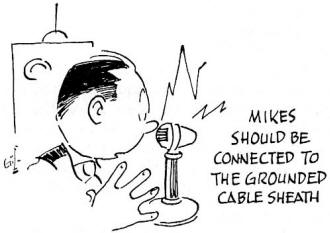 3) R. F. Units 3) R. F. Units
The requirement of grounded shielding enclosures for TVI makes the use of coil
switching highly desirable for the sake of convenience. It also provides a great
factor of safety. Since it is almost impossible to change a plug-in coil in a shielded
rig without making contact with grounded metal as well as the coil, it ought to
be made a general rule to use parallel feed in all circuits where plug-in coils
are used. If you must use series feed, use coil switching. However, it doesn't do
much good to use parallel feed if there are other exposed high-voltage points in
the vicinity of the coil. Use insulated plate connectors for tubes with cap terminals,
insulated plate leads, and place r.f. chokes under the chassis or cover up choke
terminals and those of blocking condensers.
Pi-section tank circuits do not provide a d.c. path to ground in case the blocking
condenser should blow. A receiving-type r.f, choke connected across the low-impedance
output will provide a protective path to ground and keep the plate voltage off the
coax line should the blocking condenser fail.
4) Audio Equipment
 The rules of construction set forth for
power supplies will serve equally well for most speech amplifiers and modulators.
An important additional precaution that should be taken is that the microphone stand
and enclosure should always be connected to the microphone-cable shield which, in
turn, should be grounded to the chassis. At least one ham has met death by failing
to do this. The rules of construction set forth for
power supplies will serve equally well for most speech amplifiers and modulators.
An important additional precaution that should be taken is that the microphone stand
and enclosure should always be connected to the microphone-cable shield which, in
turn, should be grounded to the chassis. At least one ham has met death by failing
to do this.
5) Auxiliary Equipment
Particular attention should be paid to the use of pick-up links for monitors
and 'scopes. Too often such links are made in haywire fashion from any piece of
wire that happens to be handy. Use well-insulated wire and ground one side of the
link.
In conclusion it should be reiterated that no voltage, including those in the
lower hundreds, can be considered free from danger. With a good contact, tests have
proved that the maximum that a person can take and still have the power to release
his grip is 40 volts a.c.! Handle every circuit with caution and remember that the
lowly 115 volts has more electrocutions to its credit than any other. None of the
measures recommended above involves any considerable amount of complication or expense.
It's just a matter of taking the time to make sure that they are complied with.
* Assistant Technical Editor, QST.
Posted June 26, 2020
(updated from original post on 7/27/2016)
|


















